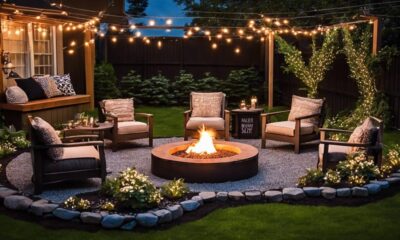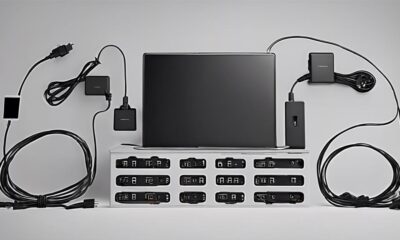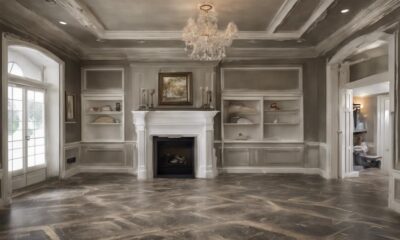Retreat
What Makes a Creative Office Space
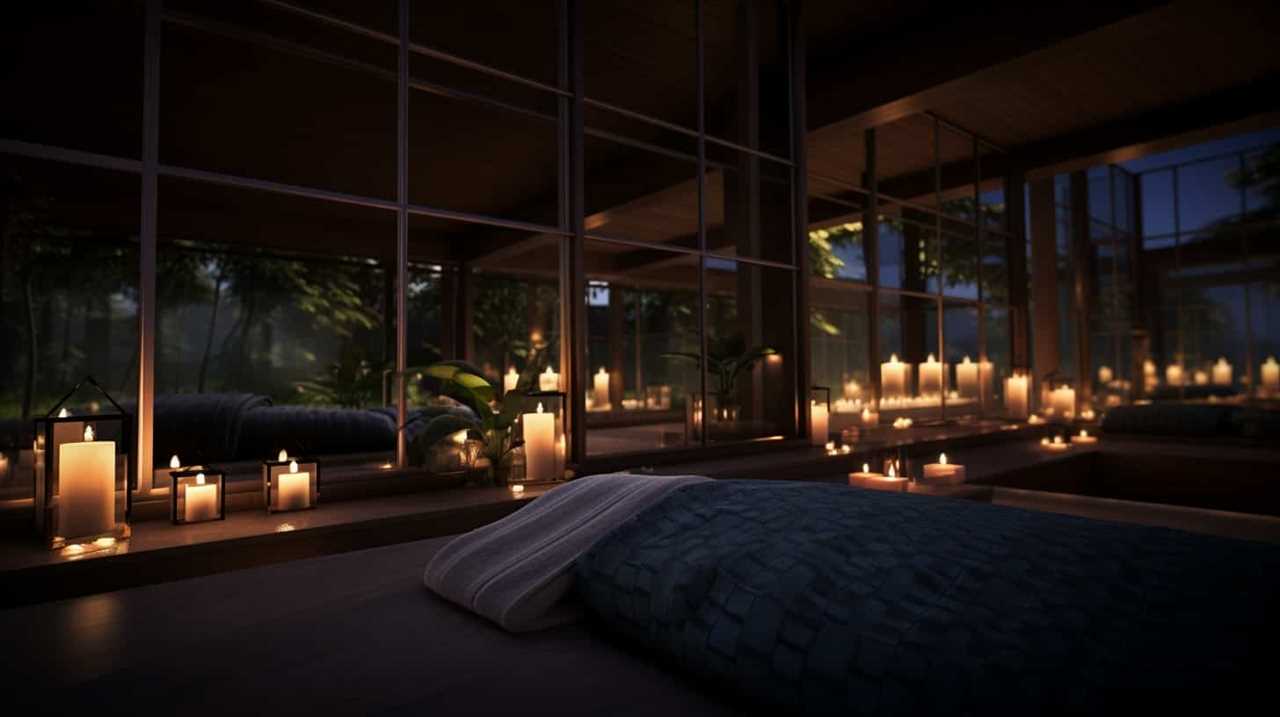
Welcome to our exploration of what makes a truly creative office space.
At its core, a creative office is like a blank canvas, inviting us to unleash our imagination and transform it into a haven of innovation.
We believe that by harnessing the power of color, embracing collaborative spaces, incorporating nature, and curating inspiring furniture, we can cultivate an environment that sparks creativity and fuels our collective passion for serving others.
So, let’s dive in and discover the secrets to crafting a truly remarkable creative office space.
Key Takeaways
- Color psychology sets the mood and atmosphere of a creative office space, with vibrant colors like yellows and oranges promoting enthusiasm and motivation, while blues and greens promote calmness and focus.
- Collaborative workstations, flexible seating arrangements, and interactive technology enhance productivity and teamwork in a creative office space.
- Incorporating natural elements such as living walls, natural light, and green roofs improves well-being, productivity, and creativity.
- Inspiring and functional furniture, including ergonomic seating options and versatile workstations, prioritize comfort, practicality, and foster creativity and collaboration.
The Power of Color and Design
We absolutely love how the use of color and design can transform an office space into a creative and inspiring environment. Color psychology plays a significant role in setting the mood and atmosphere of a workspace. By incorporating vibrant and energetic colors, such as yellows and oranges, we can create a sense of enthusiasm and motivation. On the other hand, blues and greens can promote calmness and focus.
But it’s not just about the colors; the spatial layout is equally important. Creating open and collaborative spaces encourages teamwork and communication, while providing private areas allows for concentration and individual work.
By strategically combining color psychology and spatial layout, we can design an office that stimulates creativity and productivity.
Now, let’s explore the next section on embracing collaborative spaces.
Embracing Collaborative Spaces
Collaborative spaces are essential in fostering teamwork and innovation within an office environment. They create an atmosphere where employees can come together, exchange ideas, and work towards a common goal.
To fully embrace collaborative spaces, consider the following:
Collaborative workstations: Designing workstations that allow employees to easily collaborate with their colleagues can greatly enhance productivity. This can be achieved through open concept desks or shared workstations equipped with tools for collaboration.
Flexible seating arrangements: Offering a variety of seating options encourages employees to choose the space that best suits their needs. From cozy lounges to standing desks, flexibility in seating arrangements promotes comfort and creativity.
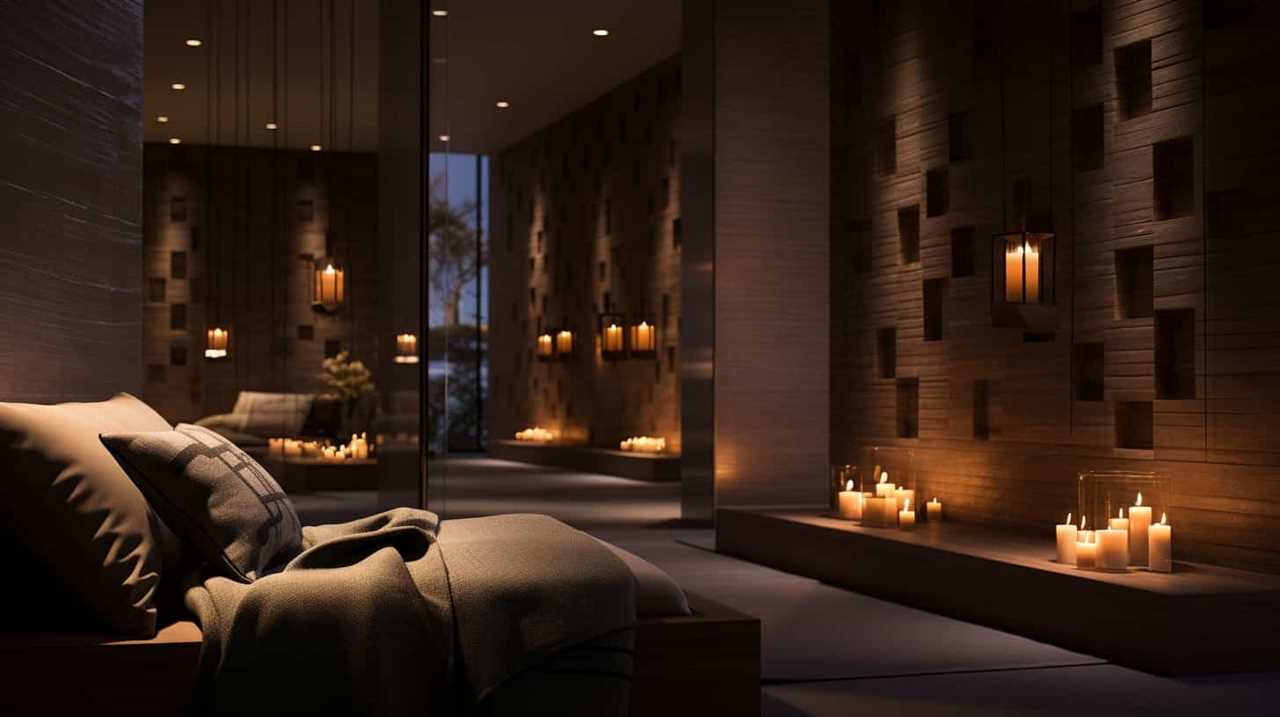
Interactive technology: Integrating interactive technology, such as digital whiteboards or video conferencing systems, can facilitate seamless collaboration between team members, even when they’re physically apart.
Incorporating Nature and Greenery
To create a truly rejuvenating and inspiring work environment, we believe that incorporating a sufficient amount of nature and greenery is essential. Biophilic design, which aims to connect people with nature in the built environment, has gained popularity in recent years for its numerous benefits. Research has shown that incorporating natural elements in the workplace has a positive impact on employee well-being, productivity, and creativity.
| Benefits of Natural Elements in the Workplace | Biophilic Design |
|---|---|
| Improved air quality | Living walls |
| Reduced stress and anxiety | Natural light |
| Increased productivity and focus | Atriums |
| Enhanced creativity and innovation | Green roofs |
Inspiring and Functional Furniture
With a combination of comfortable seating and versatile workstations, our office space is designed to foster creativity and encourage collaboration.
We understand the importance of providing ergonomic seating options that prioritize the well-being and comfort of our team members. Our chairs are adjustable, allowing individuals to find the perfect position that supports their body and promotes good posture.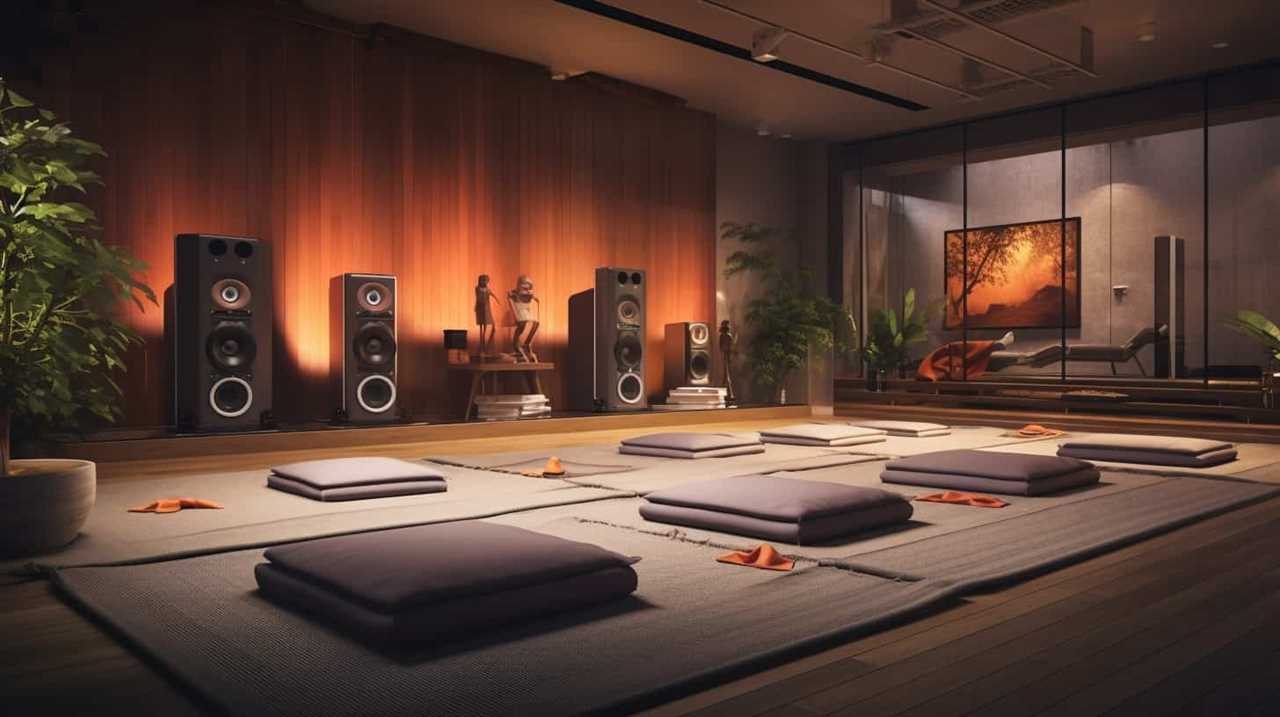
Additionally, our standing desks offer a dynamic and customizable workspace that promotes productivity and reduces the negative effects of prolonged sitting.
We believe that by providing furniture that’s both inspiring and functional, we can create an environment that supports the diverse needs and work styles of our team, ultimately leading to increased creativity and innovation.
Fostering a Culture of Innovation
Fortunately, we actively encourage and support innovation in our office space, allowing our team members to think outside the box and explore new ideas freely.
One way we foster a culture of innovation is by providing flexible workspaces. We understand that different people work best in different environments, so we offer a variety of spaces for our team members to choose from. Whether it’s a quiet corner for focused work, a collaborative area for brainstorming, or a cozy lounge for casual discussions, our office is designed to cater to all working styles.
Additionally, we believe in encouraging risk-taking. We understand that not every idea will be a success, but we believe that taking risks is essential for growth and progress. We provide a safe and supportive environment where our team members feel empowered to take risks, learn from failures, and continuously strive for innovation.
Frequently Asked Questions
Are There Any Specific Recommended Color Schemes or Designs That Have Been Found to Be the Most Effective in Promoting Creativity in an Office Space?
There are no specific recommended color schemes or designs that have been found to be the most effective in promoting creativity in an office space. The impact of lighting on creativity in the workplace is also subjective.
How Can Collaborative Spaces Be Effectively Utilized to Encourage Innovation and Creativity Among Employees?
Collaborative brainstorming and a design thinking approach are key to encouraging innovation and creativity among employees. By providing spaces that foster collaboration and inspire new ideas, we can ignite the creative spark in our team.
What Are Some Examples of Ways to Incorporate Nature and Greenery in an Office Space to Enhance Creativity and Productivity?
Incorporating nature and greenery in an office space has numerous benefits. The use of biophilic design elements, natural light, and indoor plants promotes creativity and productivity. It’s an innovative, practical, and customizable way to enhance the work environment.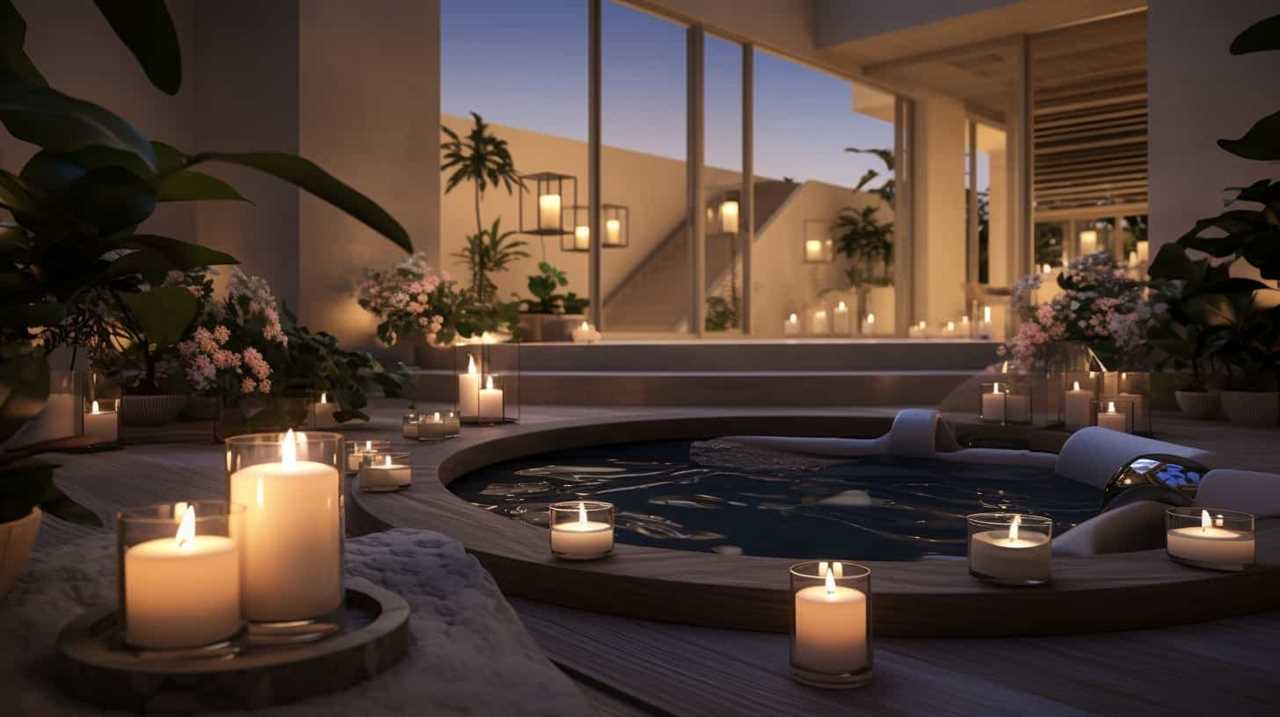
Are There Any Specific Types of Furniture That Have Been Proven to Be More Inspiring and Functional in a Creative Office Environment?
Functional furniture and inspiring decor are essential in a creative office space. We’ve found that certain types of furniture, like ergonomic chairs and adjustable desks, can enhance productivity and comfort, while unique decor elements add a touch of inspiration and personalization.
How Can a Culture of Innovation Be Fostered Within an Office Space to Encourage Creativity and Problem-Solving Among Employees?
To foster a culture of innovation, we prioritize office layout and flexible workspaces. By creating an environment that encourages collaboration and problem-solving, we empower our employees to think creatively and find innovative solutions.
How Can White Space Be Utilized in a Creative Office Space Design?
When designing a creative office space, the purpose of white space cannot be underestimated. Utilizing white space can create a sense of openness and tranquility, providing room for creativity to flourish. Intentional use of empty areas can also contribute to a sleek and modern aesthetic, enhancing the overall work environment.
Conclusion
In conclusion, creating a truly innovative and practical office space is all about finding the perfect balance between color, design, collaboration, nature, and furniture.
By incorporating these elements, we can transform a dull workspace into a vibrant hub of creativity and productivity.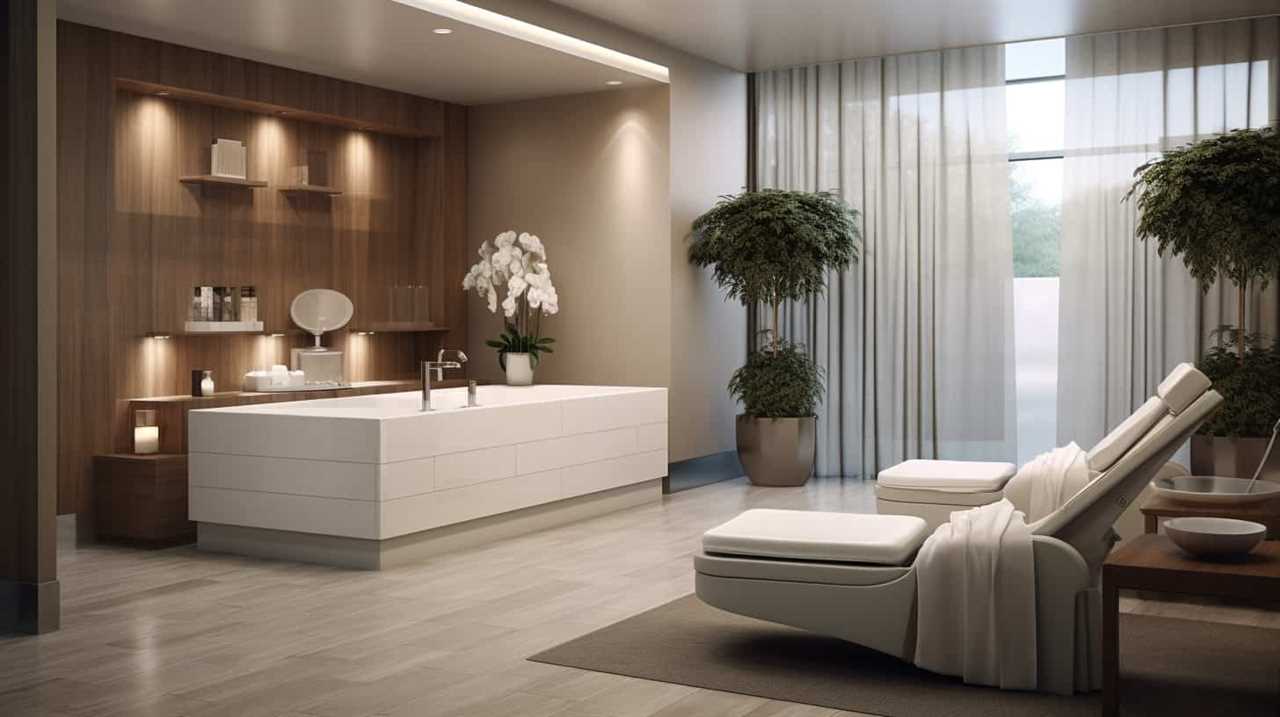
So why settle for an ordinary office when you can have a mind-blowingly awesome space that will make your competitors green with envy?
Let’s embrace the power of innovation and create a customizable office that will inspire greatness.
- About the Author
- Latest Posts
Introducing Charles, the Editor in Chief at ByRetreat, whose passion for interior design and editorial excellence elevates every remote workspace to new heights. With his keen eye for detail, impeccable taste, and expertise in design, Charles brings a wealth of knowledge and creativity to the ByRetreat team.
As the Editor in Chief of a renowned lifestyle blog, Charles has honed his skills in curating captivating content and staying up-to-date with the latest trends in interior design. His deep understanding of aesthetics and the power of storytelling through design enables him to create remote workspaces that are not only visually stunning but also rich in personality and meaning.
Retreat
Incorporating Water Features in Your Retreat Center Design
Incorporating water features in your retreat center design can transform the atmosphere, but what essential elements should you consider for the best impact?
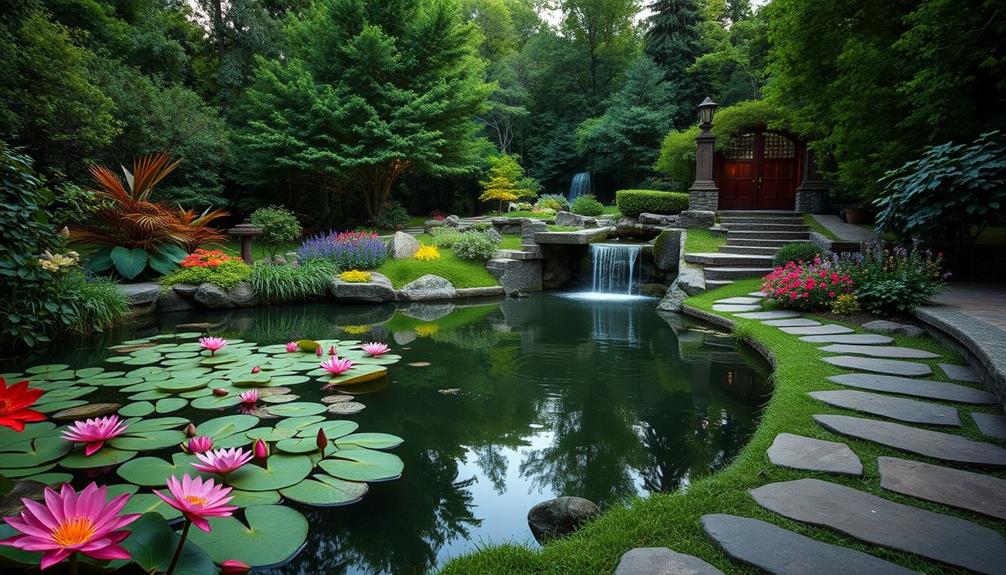
Incorporating water features in your retreat center design creates a serene environment that fosters relaxation and enhances the overall experience. Elements like flowing streams and reflective ponds not only add beauty but also promote well-being by reducing stress and encouraging mindfulness. Surround these features with lush greenery to support biodiversity and create inviting spaces for guests to unwind. Make certain your designs align with the center's theme and are eco-friendly for minimal maintenance. Thoughtful integration of water features can elevate your retreat's ambiance, making it truly unforgettable. Discover how to perfect these elements for maximum impact and guest satisfaction.
Key Takeaways
- Choose diverse water features like flowing streams and reflective ponds to enhance aesthetics and promote relaxation in your retreat center design.
- Integrate natural elements such as plants and stones around water features to foster tranquility and support local biodiversity.
- Ensure water features are low-maintenance and eco-friendly to minimize upkeep while maintaining serenity and sustainability.
- Position water features as focal points to encourage social interaction and exploration among guests in outdoor spaces.
- Align the design of water features with the overall theme of the retreat, enhancing guest experiences and promoting well-being.
Benefits of Water Features

When you incorporate water features into your retreat center design, you really elevate the overall experience for your guests. These elements bring beauty and tranquility, transforming your landscape design into a serene oasis. Striking visual focal points, like flowing fountains or cascading waterfalls, can be customized to match your center's theme, enhancing its aesthetic appeal.
Additionally, creating a calming atmosphere can be particularly beneficial for seniors, who may experience heightened stress levels; incorporating these features can promote relaxation and well-being, similar to managing behavioral issues in seniors.
The soothing sound of flowing water plays an essential role in promoting relaxation. Guests often find that the gentle murmur helps reduce stress and anxiety, creating a peaceful environment ideal for rejuvenation.
Additionally, water features contribute to local biodiversity by offering habitats for wildlife, such as birds and butterflies, which enrich the ecological value of your grounds.
Moreover, well-designed water features can help regulate temperature in outdoor spaces, making them more inviting year-round. This comfort can lead to increased guest satisfaction, encouraging repeat visits and boosting your retreat center's marketability.
Not only do water features enhance the ambiance, but they can also increase property value, making your center more attractive to potential clients in a competitive landscape. Embracing these benefits truly transforms your retreat into a sought-after destination.
Types of Water Features
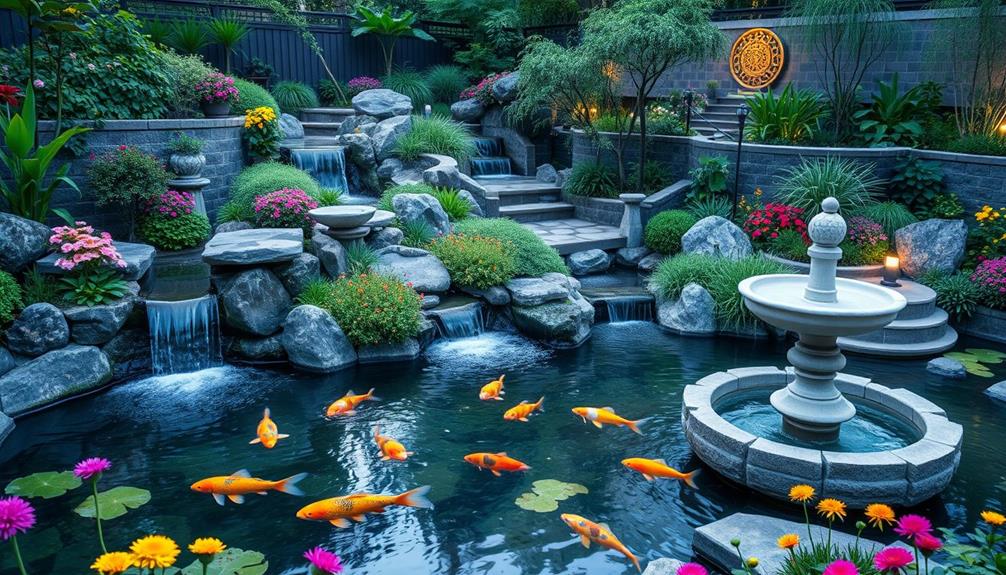
When considering types of water features for your retreat center, think about how flowing streams can transform larger spaces with their natural movement and soothing sounds.
These features can also attract local wildlife, enhancing the connection to nature and providing opportunities for wildlife observation.
Reflective ponds also offer a unique appeal, creating peaceful spots for meditation and quiet contemplation.
Each feature not only enhances the landscape but also contributes to the overall tranquility of the environment.
Flowing Streams Benefits
Incorporating flowing streams into retreat center design not only enhances the aesthetic appeal but also creates a soothing atmosphere that promotes relaxation. The gentle sound of flowing water contributes to a peaceful environment, allowing guests to unwind and rejuvenate.
Research shows that the presence of water can greatly reduce stress, making it an essential feature for any wellness-focused retreat. Additionally, the calming effects of natural elements, including water features, can be compared to the benefits of cold medications overview that alleviate discomfort and enhance well-being during stressful times.
Flowing streams can also break up large spaces, adding visual interest and guiding movement throughout the area. By strategically placing these water features, you can create a natural flow that encourages exploration and connection with nature.
Additionally, flowing streams support biodiversity by providing habitats for various wildlife, attracting birds and insects that enrich the overall experience for your guests.
Customization is another advantage of incorporating flowing streams. You can tailor the width, depth, and surrounding vegetation to harmonize with the natural landscape, ensuring that the design feels cohesive.
Whether you envision a meandering stream or a more structured waterway, these elements can transform your retreat center into a truly serene sanctuary, enhancing both its beauty and the well-being of those who visit.
Reflective Ponds Appeal
Reflective ponds offer their own unique appeal, complementing the soothing qualities of flowing streams. These serene environments encourage contemplation and relaxation, making them ideal for retreat centers focused on well-being and mindfulness.
The beauty of reflective ponds lies not only in their visual allure but also in their ecological benefits, much like the way DIY Fire Pit Ideas can enhance outdoor spaces with inviting designs.
Here are four key reasons to incorporate reflective ponds into your design:
- Calming Atmosphere: The tranquil surfaces of reflective ponds create a peaceful setting, perfect for meditation or quiet reflection.
- Biodiversity Enhancement: By serving as habitats for fish, birds, and other wildlife, these ponds promote a vibrant ecosystem within your retreat's landscape.
- Visual Expansion: Reflective ponds can visually expand outdoor spaces, serving as a stunning focal point for gatherings and events.
- Biophilic Design: Incorporating lush greenery and natural materials around the ponds fosters a stronger connection between occupants and nature.
To guarantee the longevity and enjoyment of these calming features, regular maintenance is essential. Keeping the water clear and healthy enhances the overall experience, allowing you and your guests to fully appreciate the tranquility that reflective ponds provide.
Integrating Natural Elements
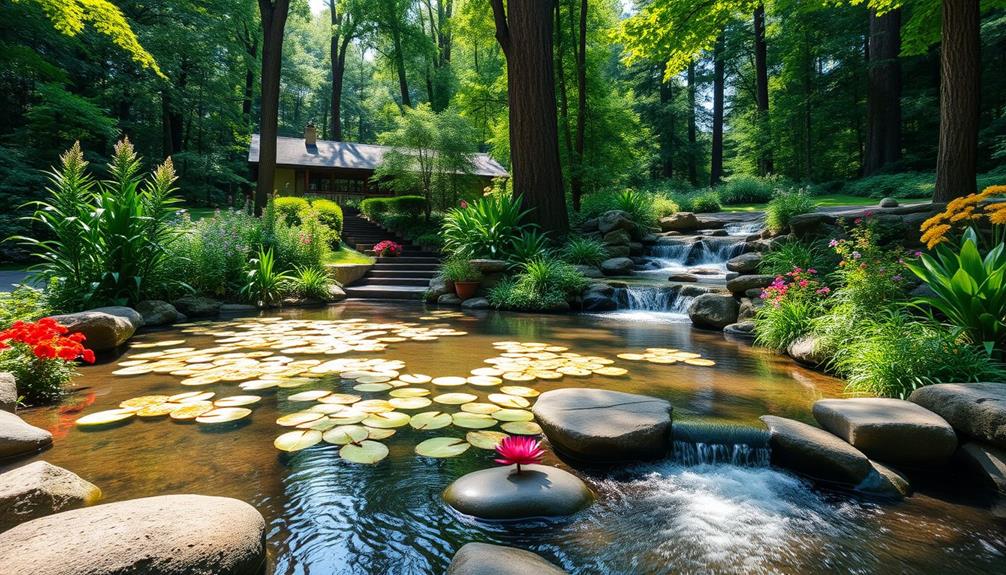
When you integrate natural elements like plants and stones around your water features, you not only enhance the aesthetic appeal but also promote biodiversity.
This connection to nature invites a sense of tranquility, making it easier for guests to unwind.
Enhancing Aesthetic Appeal
Throughout the design of a retreat center, integrating natural elements like plants and rocks around water features considerably enhances aesthetic appeal.
Elements such as a well-draining soil mix can support lush greenery, which is crucial for creating a tranquil outdoor space. This seamless connection between water and its surroundings is essential for promoting relaxation for your visitors.
By incorporating these elements, you can elevate the beauty and best soil for String of Hearts plants and promote a serene atmosphere. Here are some effective strategies:
- Lush Greenery: Surround reflective ponds with vibrant plants to amplify the calming effects of water and beautify the landscape.
- Natural Stone: Use materials like natural stone for pathways or seating areas, adding texture while harmonizing with the environment.
- Focal Points: Position water features strategically to create eye-catching focal points that encourage exploration of the outdoor areas.
- Diverse Features: Incorporate various water elements, such as wall-mounted waterfalls or tranquil ponds, to reflect the center's identity and enhance guest experiences.
Promoting Biodiversity Benefits
Integrating water features into your retreat center design not only creates a visually appealing landscape but also promotes biodiversity. By including elements like ponds and reflective pools, you can attract a variety of wildlife, such as birds and butterflies, which enhances biodiversity and supports local ecosystem health.
These water features provide essential habitats for aquatic life, fostering ecological diversity that benefits both the environment and your guests' experiences. Implementing energy-efficient systems, like the best heat pumps, can further enhance the sustainability of your retreat center.
The presence of water supports natural pollination and pest control, helping to maintain a balanced ecosystem. Strategically placing these features amidst lush greenery creates serene environments that encourage relaxation while nurturing a healthy ecosystem.
You'll also find that utilizing natural materials, like rocks and native plants around your water features, amplifies your connection to the surrounding landscape.
This integration not only beautifies your retreat center but also guarantees it contributes positively to the local ecosystem. By promoting biodiversity, you're creating a space where guests can truly connect with nature, enhancing their retreat experience while supporting ecological sustainability.
Enhancing Sensory Experiences
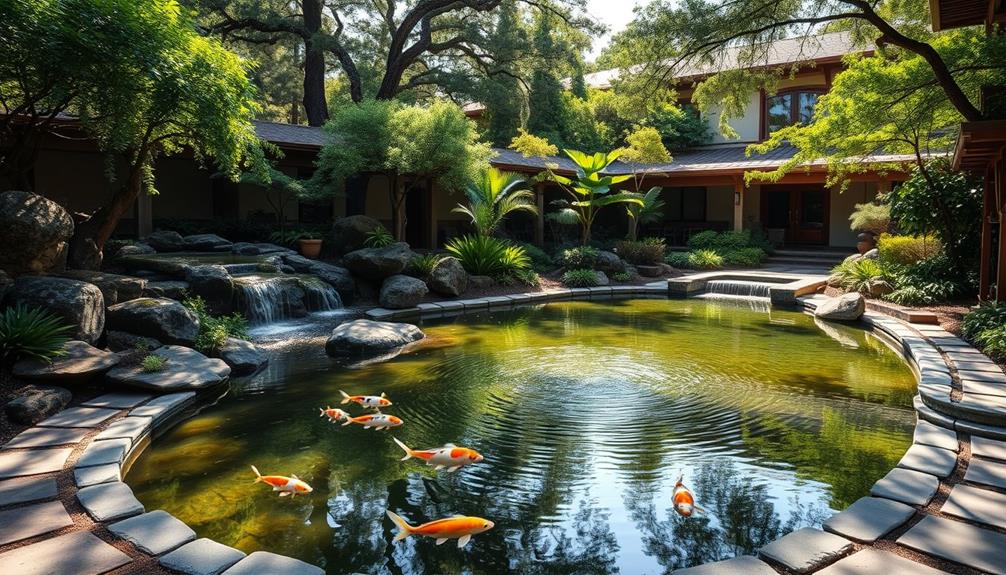
Water features play an essential role in enhancing sensory experiences at retreat centers. The sound of flowing water from fountains and waterfalls creates a calming ambiance that helps reduce stress and promote relaxation.
By incorporating water features, you engage multiple senses, inviting guests to experience a serene environment. Additionally, well-structured content that highlights the benefits of these features can boost credibility and trustworthiness, ultimately enhancing the overall guest experience and engagement metrics, as seen in holistic SEO approaches.
Here are four ways water features enhance sensory experiences:
- Sound: The soothing sounds of water create a tranquil atmosphere, perfect for meditation and mindfulness practices.
- Visual Movement: Gentle ripples and cascading flows offer a dynamic visual element, promoting a sense of peace.
- Tactile Experiences: Guests can engage with water through reflection ponds or interactive features, encouraging a deeper connection with nature.
- Wildlife Attraction: Water features can draw in birds and other wildlife, adding visual interest and enriching the overall experience.
Design Considerations

When planning a water feature for a retreat center, thoughtful design considerations are vital for guaranteeing it enhances the overall experience. Start by evaluating the scale and proportion of your water feature. An oversized installation can overwhelm a small space, while a tiny one might go unnoticed.
Achieving harmony with the existing architectural elements is important, so choose a style that complements the retreat center's theme. Incorporating natural materials can further enhance the aesthetic, creating a seamless blend with the environment, much like the eco-friendly aspects found in wood pellet fireplaces.
Don't forget about maintenance requirements. Opting for low-maintenance designs allows you to create a serene environment without the burden of extensive upkeep. Familiarize yourself with local regulations, as some areas may impose specific guidelines or permit needs for water features.
Accessibility is another key factor in your design considerations. Guarantee the water feature is easily visible and accessible to all guests, encouraging interaction and engagement with the natural elements.
Maintenance Best Practices
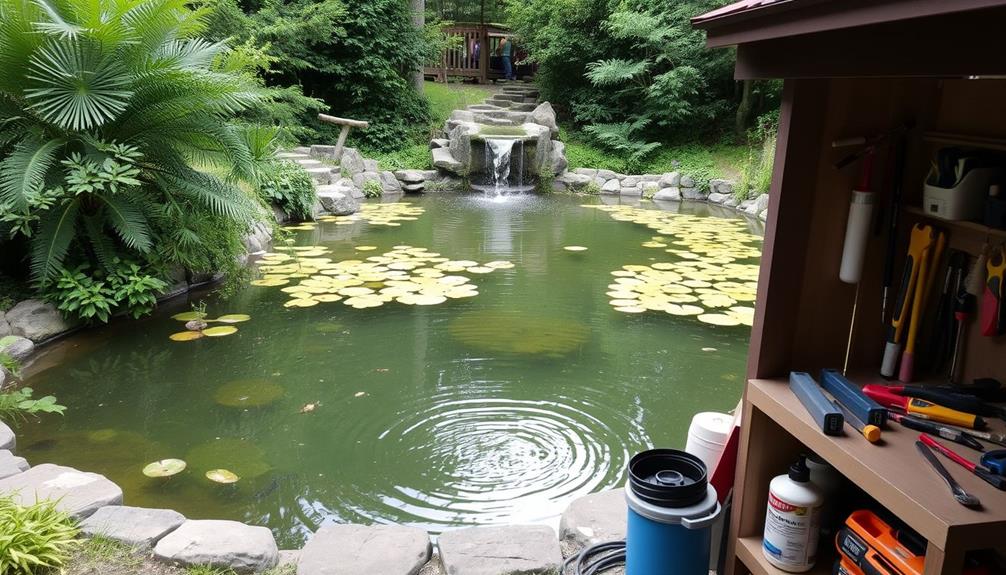
To guarantee your water feature remains a stunning focal point, regular maintenance is key. By following these best practices, you can ascertain its longevity and beauty while creating a healthy environment for wildlife.
Additionally, incorporating elements like hydrotherapy techniques can enhance the overall ambiance and therapeutic benefits of your retreat center.
- Implement a Maintenance Log: Track cleaning schedules, water quality tests, and equipment checks. This log helps you maintain a consistent upkeep routine and spot potential issues before they escalate.
- Conduct Routine Checks: Regularly inspect pumps and lighting systems for proper installation and functionality. This prevents disruptions in water flow or illumination that can detract from the visual appeal.
- Address Algae Growth Promptly: Keep an eye on algae development. Excessive growth can lead to murky water and an unhealthy habitat for aquatic life, so tackle it as soon as you notice it.
- Schedule Cleaning: Regularly remove debris and sediment from your water feature. This not only enhances its aesthetic but also contributes to its overall health and functionality.
Creating Spaces for Relaxation
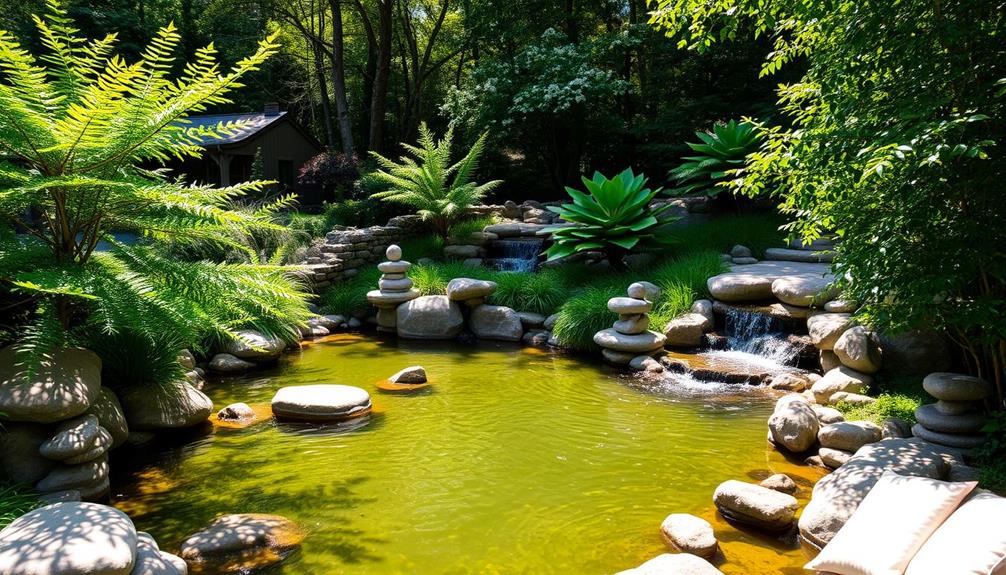
Creating a serene environment with water features can greatly enhance relaxation in a retreat center. By incorporating water features like tranquil ponds and cascading fountains, you create a peaceful atmosphere that invites guests to unwind. The soothing sounds of flowing water not only mask noise but also reduce stress and anxiety, making it ideal for your relaxation-focused space.
Additionally, the use of sustainable energy solutions, such as solar power applications, can further complement the natural ambiance and promote an eco-friendly retreat experience.
Consider integrating reflective ponds surrounded by lush greenery. This natural setting encourages meditation and introspection, allowing guests to connect with nature. The presence of water features also attracts wildlife, such as birds and butterflies, enriching the sensory experience and deepening this connection.
Thoughtfully designed water elements can transform outdoor areas into peaceful oases where visitors feel rejuvenated. Whether it's a small fountain or a larger pond, these features provide calming visuals and sounds that promote overall well-being.
Incorporating water features into your retreat center design isn't just about aesthetics; it's about creating spaces that nurture relaxation and foster a tranquil environment. By prioritizing these elements, you can guarantee that your guests leave feeling refreshed and renewed.
Boosting Aesthetic Appeal
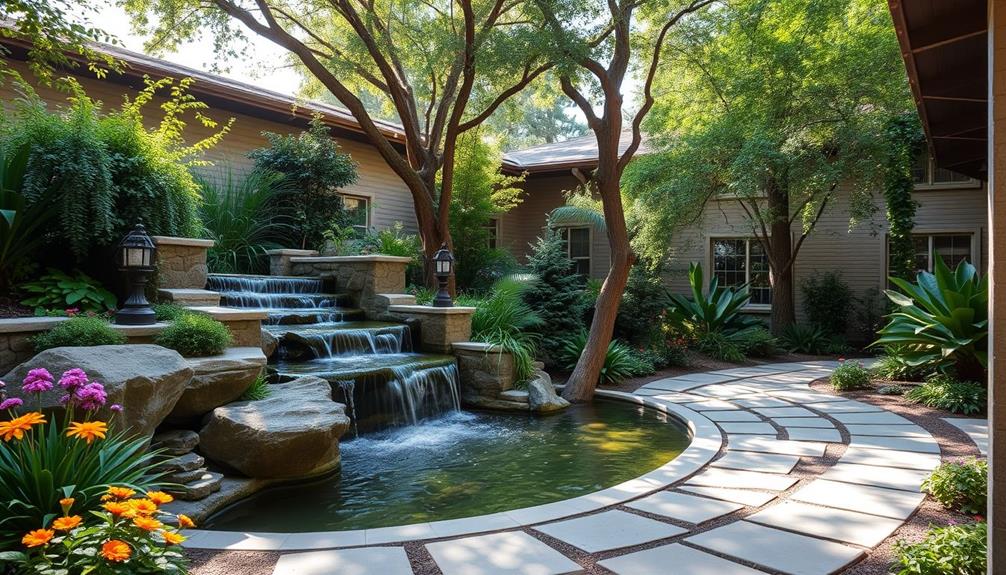
Enhancing the aesthetic appeal of a retreat center often starts with the strategic incorporation of water features.
These elements, like fountains and reflective ponds, not only provide visual allure but also create memorable experiences for your guests.
Here's how you can effectively use water features to boost your center's aesthetic:
- Create Focal Points: Position water features in key areas to draw attention and encourage exploration. A well-placed fountain can become a gathering spot for guests.
- Complement Architectural Styles: Choose designs that align with your retreat's architecture. Options range from modern cascades to naturalistic ponds, ensuring a cohesive look.
- Enhance with Natural Elements: Surround your water features with lush vegetation and natural materials. This blend fosters a tranquil ambiance that resonates with the retreat's purpose.
- Customize for Impact: Utilize lighting and water movement to create unique displays. Customized features can elevate your overall landscape design, making your retreat memorable and enticing repeat visits.
Engaging Guests With Nature
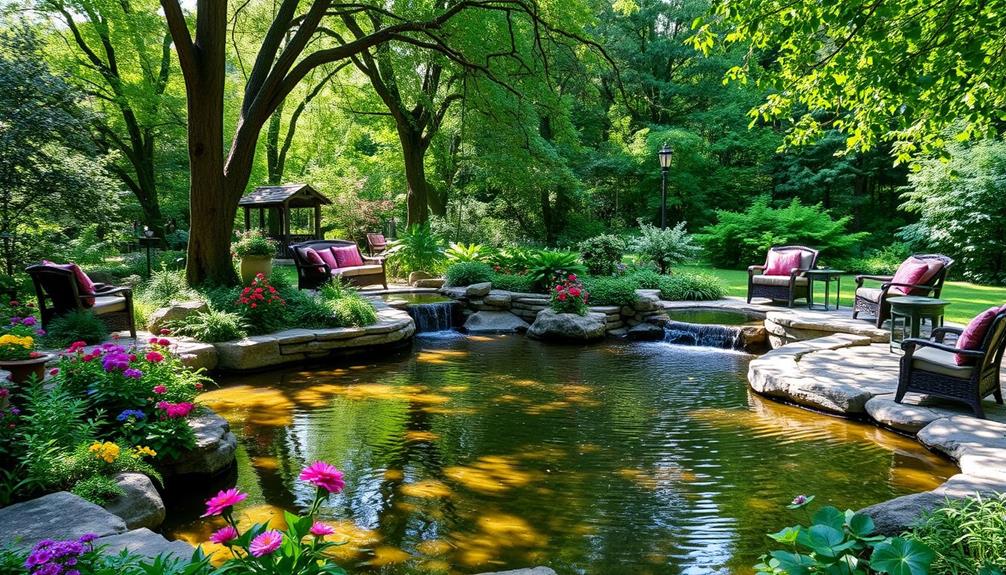
Engaging guests with nature transforms their retreat experience into a journey of discovery and relaxation. By integrating water features like tranquil ponds and cascading fountains, you create a soothing atmosphere that enhances the sensory experience. The gentle sounds of flowing water not only promote relaxation but also reduce stress levels, allowing guests to unwind fully.
Incorporating reflective ponds and flowing streams into your landscape design offers unique benefits. These features attract local wildlife, fostering a deeper connection between your guests and the natural world. Research shows that environments enriched with biophilic elements, including water, can lead to a 36% increase in dwell time. This encourages guests to linger longer and truly engage with their surroundings.
Moreover, integrating lighting into water features can create mesmerizing nighttime displays, enhancing the ambiance during evening activities. Strategically placed water features also serve as gathering points, promoting social interaction among guests and enriching their overall experience.
Frequently Asked Questions
How Do Water Features Affect Local Wildlife Populations?
Water features create habitats that attract various wildlife, providing drinking sources and breeding grounds. You'll notice increased bird activity and diverse insects, enhancing your local ecosystem while contributing to a vibrant, thriving environment in your area.
What Materials Are Best for Constructing Water Features?
When considering materials for constructing water features, you'll want to choose durable stones, smooth pebbles, and resilient liners. Each material contributes beauty, enhances functionality, and guarantees longevity, creating an inviting and harmonious environment for all.
Can Water Features Be Eco-Friendly?
Absolutely, water features can be eco-friendly! You can use sustainable materials, collect rainwater, and create natural filtration systems. By doing this, you'll enhance your space while promoting environmental health and conserving resources.
What Is the Ideal Size for a Retreat Center Pond?
The ideal size for a retreat center pond depends on your available space and intended use. Generally, a pond should be at least 20 feet wide and 30 feet long to create a tranquil atmosphere.
How Can I Incorporate Water Features Within a Limited Budget?
When it comes to budget-friendly water features, think of them as jewels in your landscape's crown. You can use simple materials, like barrels or small fountains, to create tranquil spots without overspending.
Conclusion
Incorporating water features into your retreat center design not only enhances the beauty but also nurtures the spirit. You'll create calming spaces that invite relaxation, foster connection with nature, and engage the senses. As guests listen to the gentle flow and feel the invigorating mist, they'll find tranquility and inspiration. By embracing these elements, you're not just designing a space; you're crafting an experience that rejuvenates the mind, soothes the soul, and elevates the spirit.
- About the Author
- Latest Posts
Introducing Ron, the home decor aficionado at ByRetreat, whose passion for creating beautiful and inviting spaces is at the heart of his work. With his deep knowledge of home decor and his innate sense of style, Ron brings a wealth of expertise and a keen eye for detail to the ByRetreat team.
Ron’s love for home decor goes beyond aesthetics; he understands that our surroundings play a significant role in our overall well-being and productivity. With this in mind, Ron is dedicated to transforming remote workspaces into havens of comfort, functionality, and beauty.
Retreat
How to Create and Market Day Retreat Packages
With expert tips on crafting and promoting day retreat packages, discover the secrets to attracting participants and ensuring unforgettable experiences.
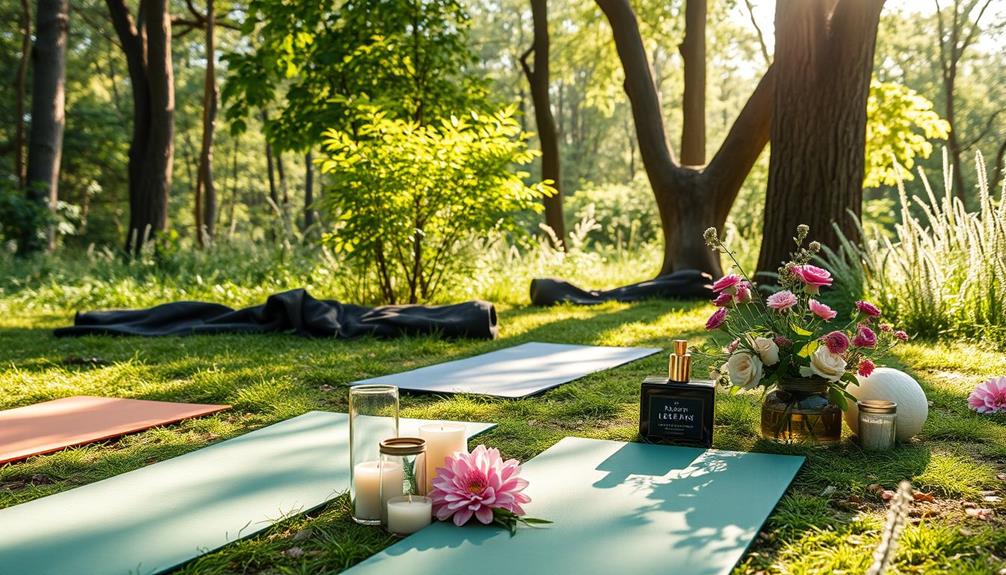
To create and market day retreat packages, start by defining clear objectives and understanding your target audience's needs. Select a comfortable venue and structure your activities with a mix of workshops and downtime. Craft a compelling value proposition that highlights unique benefits. Promote your retreat through social media, email campaigns, and influencer collaborations to reach more potential participants. Use high-quality visuals and testimonials to enhance your marketing materials. Finally, gather feedback post-retreat to improve future offerings. With these steps, you'll be well on your way to running successful day retreats. There's more to explore!
Key Takeaways
- Define clear objectives for your retreat to guide planning and communicate effectively in marketing materials.
- Understand your target audience's desires and pain points to create compelling packages that resonate with them.
- Choose a suitable venue that aligns with your retreat goals and enhances participant comfort and experience.
- Utilize social media and email campaigns to promote the unique benefits of your retreat and engage potential participants.
- Gather feedback and testimonials post-retreat to refine future offerings and enhance credibility in marketing efforts.
Understanding Day Retreats

When you think about day retreats, imagine a rejuvenating break from your daily routine that lasts just a few hours to a full day. These retreats focus on relaxation, personal development, and community building, offering a revitalizing escape without the commitment of overnight stays.
You'll find a mix of structured activities like workshops, yoga sessions, and group discussions, all designed to foster connection and growth. Incorporating elements such as heartfelt expressions of love can create a more profound impact on participants' experiences.
Understanding your target audience is essential when planning your retreat. Tailor your offerings to specific themes—be it wellness, creativity, or team-building—to guarantee you're meeting the unique needs of participants. This versatility makes day retreats appealing to a wide range of demographics, from busy professionals seeking a brief reprieve to individuals looking for personal growth experiences.
To effectively promote your retreat, consider your marketing strategies carefully. Highlight the benefits of a short, impactful experience that enhances engagement and builds relationships.
Benefits of Hosting Retreats
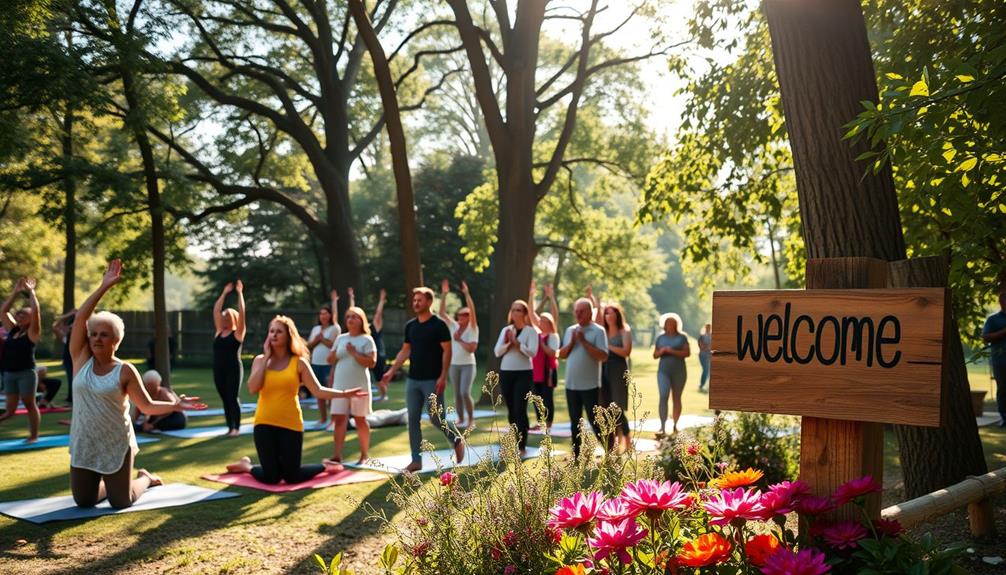
Hosting day retreats offers numerous benefits that extend beyond the immediate experience for both organizers and participants. When you engage in hosting retreats, you create an environment that fosters deeper connections with attendees, leading to increased brand loyalty and client retention. Participants often feel more valued and engaged in this unique setting.
Additionally, retreats can harness the power of imagination, enabling participants to explore transformative possibilities that enhance their personal and professional growth.
These retreats provide a dedicated space for learning and collaboration, allowing everyone to step away from their daily routines. This focused atmosphere encourages personal and professional development, boosting creativity and productivity. Attendees frequently leave with innovative ideas and solutions they mightn't have conceived in typical settings.
From a financial perspective, organizing retreats can serve as a lucrative income generator. Satisfied attendees can become repeat customers and refer others, enhancing your revenue over time.
Furthermore, wellness retreats greatly improve participant well-being, as they typically include activities centered on relaxation, reflection, and personal growth. This focus on well-being contributes to a more fulfilled and balanced life for your attendees, making your retreats not just an event but an enriching experience.
Essential Planning Tips
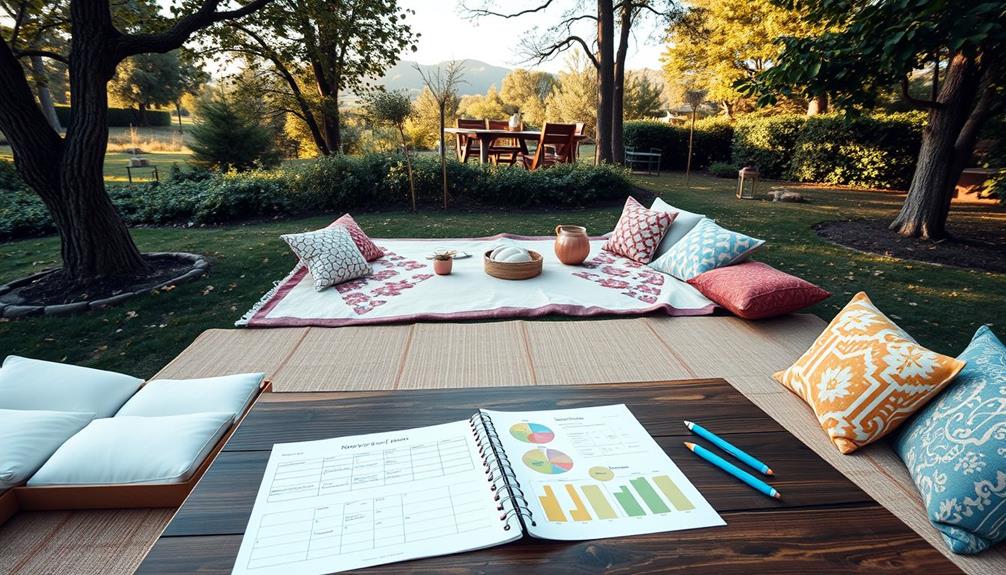
When planning your day retreat, it's essential to define your objectives clearly. This will guide every aspect of the event, from the activities you choose to the venue you select.
Incorporating elements of design thinking can enhance your planning process by ensuring that you prioritize user experience and foster collaboration among participants.
An ideal venue not only aligns with your goals but also creates a comfortable space for participants to engage and relax.
Define Objectives Clearly
Defining objectives clearly is essential for the success of your day retreat. Start by identifying the primary purpose of the retreat—whether it's relaxation, skill-building, or team-building. This focus helps guarantee that your planning aligns with your core goals.
Establish specific objectives, like the number of participants and desired outcomes for attendees. These will guide your retreat's structure and content.
Incorporating elements like the importance of astrology and attractiveness may also enhance the appeal of your retreat, making it more relatable to potential participants.
Next, align your agenda with these defined objectives. Select activities, speakers, and experiences that directly contribute to achieving your goals. This alignment not only enhances the retreat experience but also guarantees that participants find value in what you offer.
Don't forget to communicate your retreat's objectives in all your marketing materials. By doing this, you can attract the right people who resonate with your vision and set appropriate expectations for participants.
Consider incorporating feedback mechanisms during and after the retreat to assess whether your objectives were met. This approach not only enhances your current retreat but also informs future planning efforts, refining your marketing strategy and guaranteeing continued success.
Select Ideal Venue
Selecting the ideal venue for your day retreat sets the stage for a successful experience. Choose a retreat center that aligns with your theme, offering amenities that enhance relaxation and engagement. Look for natural surroundings for outdoor activities or spacious rooms for workshops to create the best user experience.
Considering the importance of financial considerations for elderly care can also inform your selection if your retreat is aimed at caregivers or seniors.
Accessibility is vital, so select a location that's easily reachable by public transport or major highways. Provide clear directions to avoid confusion among participants.
Evaluate the venue's capacity to comfortably accommodate your expected number of attendees, keeping in mind breakout sessions and communal spaces for networking.
Essential facilities like adequate parking, restrooms, and catering options will simplify logistics and enhance the overall experience. Make sure your venue can support these needs.
Additionally, assess the availability of extra services, such as technical support for audiovisual equipment or wellness offerings like massage therapy. These features can create a thorough retreat package that participants will appreciate.
Crafting Compelling Packages
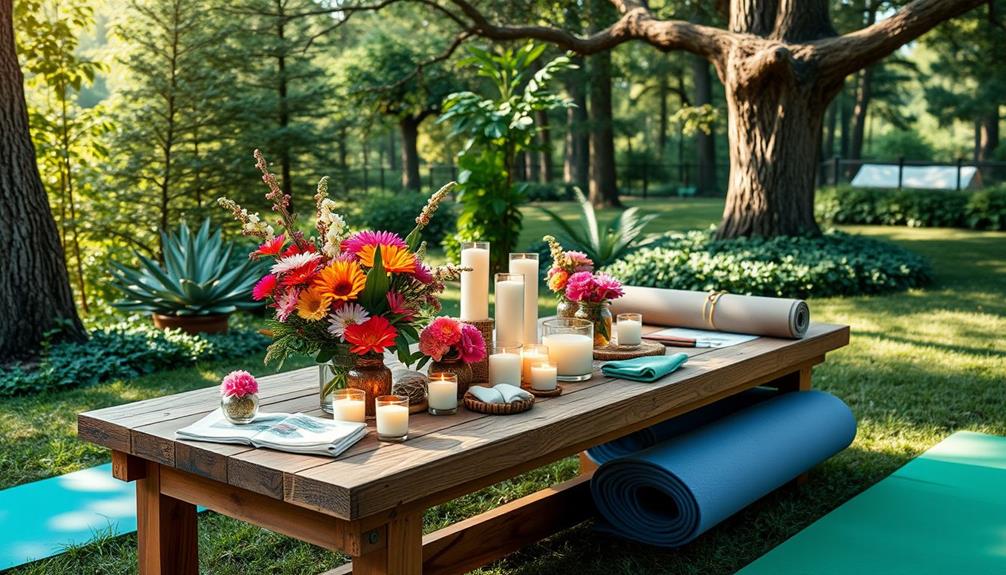
Crafting compelling packages for your day retreat requires a keen understanding of your audience's desires and challenges. Start by defining your target audience. Identify their interests, needs, and pain points to tailor offerings that truly resonate.
Consider incorporating elements that promote relaxation and wellness, such as hydrotherapy, which can enhance the therapeutic aspect of your retreat. Next, create a compelling value proposition that highlights the unique benefits of your retreat, such as stress relief, personal growth, or skill development. This will be essential in your retreat marketing efforts.
Structure your packages to include a balanced mix of activities—workshops, wellness sessions, and downtime—to guarantee participants have a fulfilling and rejuvenating experience throughout the day. Flexibility is key; consider incorporating pricing options like early-bird discounts or group rates to incentivize bookings and encourage word-of-mouth referrals among attendees.
Additionally, don't underestimate the power of visuals and testimonials in your marketing materials. High-quality images and authentic feedback from past participants can help potential customers visualize themselves at your retreat, enhancing credibility and interest.
Marketing Your Retreat Effectively
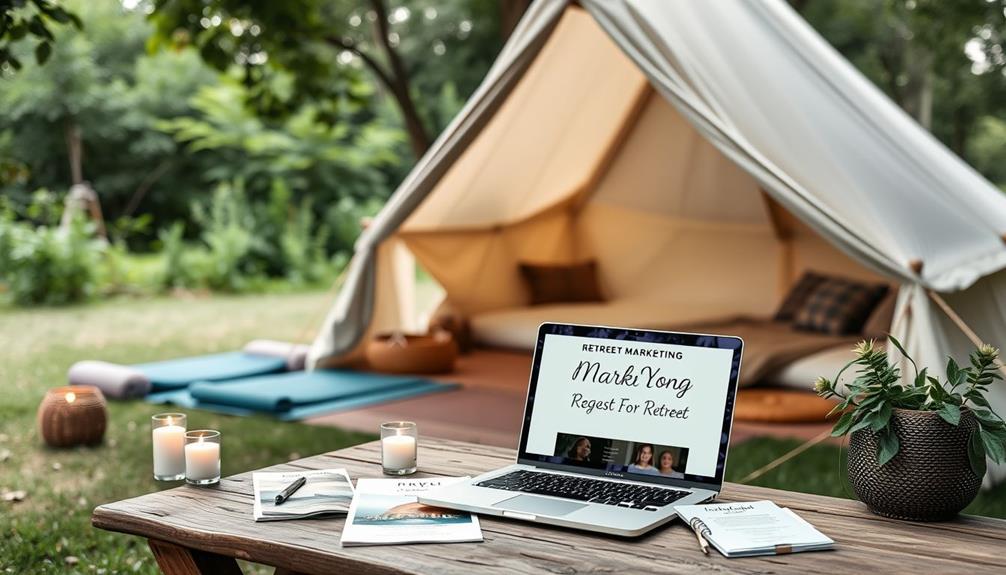
To market your retreat effectively, you first need to identify your target audience and understand their needs.
Researching best ways to earn money online can also provide insights into what potential attendees may be seeking in a retreat experience.
Once you know who you're speaking to, create compelling content that highlights the unique experiences your retreat offers.
Engaging with your audience on social media will help you build excitement and draw in potential attendees.
Target Audience Identification
Identifying your target audience is essential for effectively marketing your day retreat packages, as it allows you to tailor your messaging to resonate with potential attendees. Start by pinpointing specific demographics like age, interests, and lifestyle preferences that align with your offerings. This foundational step in target audience identification helps you refine your marketing strategies.
Additionally, consider how outdoor enthusiasts are drawn to unique experiences, such as diverse tent camping locations, which can inform your retreat themes and activities.
Conduct surveys or focus groups within your existing client base to gather insights about their needs and expectations for day retreats. This feedback can guide your offerings and make your marketing efforts more impactful.
Additionally, utilize social media analytics to discover which platforms your target audience engages with most, focusing on spaces like Instagram and Facebook.
Create compelling personas based on your ideal participants, incorporating their challenges and desires. This approach can enhance your messaging and result in more relatable promotional content.
Compelling Content Creation
Once you've pinpointed your target audience, the next step is to create compelling content that resonates with them. Start by utilizing high-quality images and videos that capture the essence of your day retreat. For inspiration, consider how creative breakfast crepes recipes can elevate a retreat's culinary offerings, showcasing activities, participant engagement, and the venue to create an appealing visual narrative. This is essential for effective content creation in your social media marketing efforts.
Next, craft blog posts or social media content that address the common challenges or desires of your audience. Position your retreat as a solution for personal growth and relaxation.
Don't forget to leverage testimonials from past participants; these build trust and credibility by highlighting transformative experiences.
To drive action, use targeted social media ads and email marketing campaigns to promote early-bird pricing or exclusive offers, enticing potential attendees to register quickly.
Social Media Engagement
Engaging on social media is essential for successfully marketing your day retreat. It's a powerful tool to help you market your offerings and connect with potential attendees. Incorporating elements like music therapy integration in your retreat can also be showcased through social media, emphasizing the emotional well-being benefits participants can experience.
Here are three effective strategies to boost your social media engagement:
- Showcase Your Retreat: Utilize visually appealing platforms like Instagram and TikTok. Share high-quality images and engaging videos that highlight unique activities and the serene environment of your retreat.
- Leverage Hashtags and Geo-tags: Use trending hashtags and geo-tags to expand your reach. This guarantees your posts are discoverable by those interested in wellness and personal development experiences, increasing your visibility.
- Encourage User-Generated Content: Ask past participants to share their experiences and tag your retreat. This not only amplifies your visibility but also builds a sense of community around your brand.
Additionally, create compelling stories or reels that capture behind-the-scenes moments and participant testimonials. Consistently engage with your audience through interactive content like polls and Q&As.
Engaging Your Audience
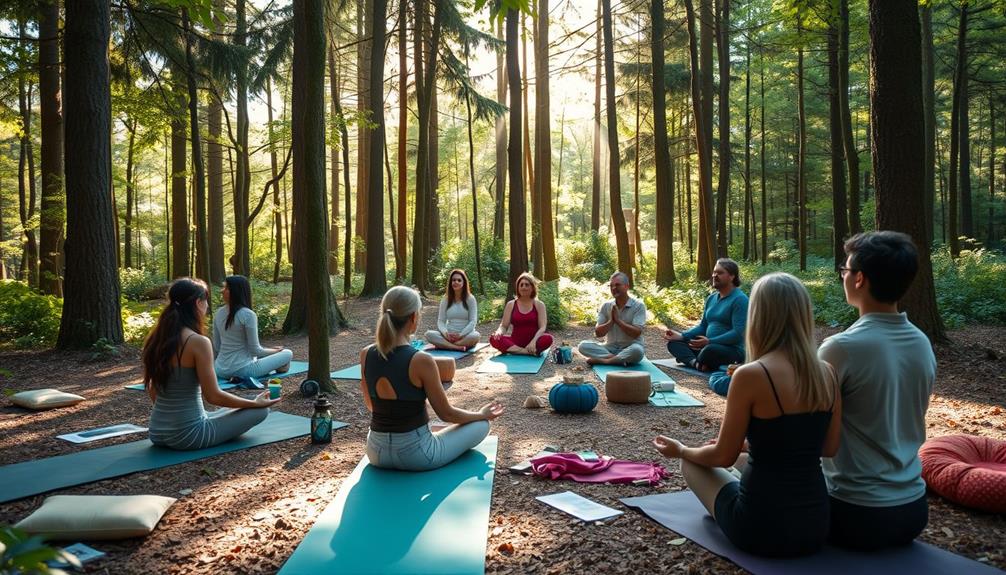
Capturing your audience's attention is essential for the success of your day retreat packages. Engaging your audience goes beyond just informing them; it's about creating a connection.
Start by showcasing stunning visuals and authentic stories from past retreats on platforms like Instagram and Facebook. These images will resonate with potential attendees and illustrate the positive impact your retreats can have on their well-being.
You also need to know that interactive content can boost involvement. Consider using polls or Q&A sessions to invite feedback on retreat themes and activities. This not only engages your audience, but it also helps you tailor your offerings to their interests.
Don't forget about targeted email marketing. Highlight unique offerings and early-bird discounts to foster a sense of urgency and exclusivity. Sharing testimonials and success stories from previous participants builds trust and credibility, demonstrating the tangible benefits of attending your retreats.
Lastly, leverage partnerships with influencers or local wellness practitioners. Their established audiences can enhance visibility for your day retreat packages, attracting more attendees and expanding your reach.
Utilizing Social Media
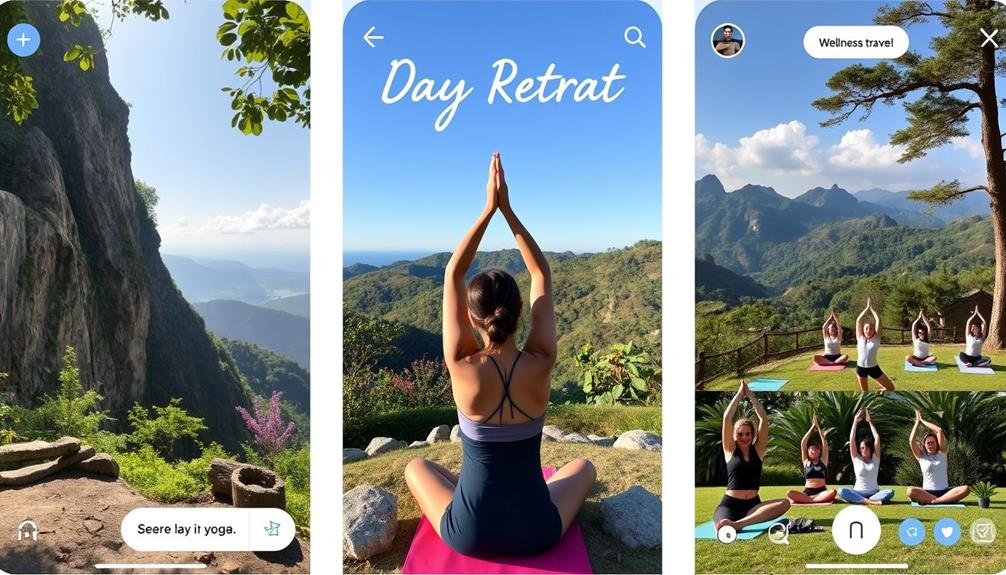
In today's digital landscape, utilizing social media is essential for promoting your day retreat packages effectively. To reach a wider audience and attract potential attendees, focus on creating engaging content that resonates with your target market.
Here are three strategies to enhance your social media presence:
- Leverage Visual Platforms: Use visually-driven platforms like Instagram and TikTok to showcase your retreat. High-quality images and engaging videos can capture attention and highlight unique aspects of your offerings.
- Use Trending Hashtags: Incorporate trending hashtags related to wellness, relaxation, and personal development in your posts. This practice boosts your visibility and connects you with individuals interested in these themes.
- Collaborate with Influencers: Partner with influencers in the wellness space to increase your exposure and credibility. Their endorsements can greatly amplify your reach and attract new clients.
Regularly update your channels with behind-the-scenes content, participant testimonials, and sneak peeks of activities.
This consistent engagement fosters excitement and builds a community around your retreat, making it more appealing to potential attendees.
Gathering Feedback and Testimonials
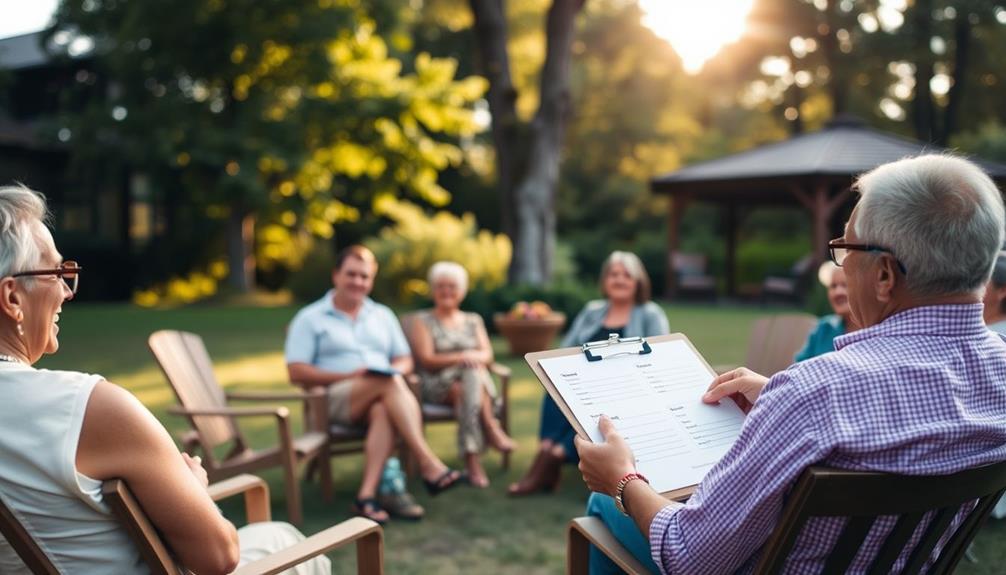
Regularly gathering feedback and testimonials is essential for enhancing your day retreat packages. Collecting feedback immediately after the retreat can provide valuable insights into participants' experiences, helping you pinpoint strengths and areas for improvement.
Use short questionnaires or surveys to facilitate this process; they encourage participants to reflect on their experiences while they're still fresh in their minds.
Don't underestimate the power of authentic testimonials in your marketing efforts. Display them prominently on your website and social media platforms to increase trust and credibility.
Potential clients are more likely to register for future retreats when they see positive reviews from previous attendees.
Pay attention to feedback from those who didn't register, too. Analyzing their objections can help you refine your offerings, ensuring they better meet the needs of your target audience.
Keep things fresh by regularly updating your marketing content with new testimonials and participant feedback. This not only attracts new clients but also boosts interest in upcoming retreats.
Frequently Asked Questions
How Do I Create a Retreat Program?
To create a retreat program, establish clear objectives, choose a fitting venue, develop a balanced agenda, incorporate engaging activities, and gather feedback afterward. This process guarantees your program meets participants' needs and enhances their experience.
How Do You Plan a Retreat Day?
Planning a retreat day is like orchestrating a symphony! Start by defining your objectives, choose a fitting venue, structure a balanced agenda, incorporate interactive elements, and gather feedback to perfect your future events.
How Do You Create a Budget for a Retreat?
To create a budget for your retreat, estimate fixed and variable costs, allocate a contingency fund, and set a pricing strategy. Regularly review your budget to guarantee you're covering expenses while maintaining profit margins.
How Do I Market My Retreat?
You've got a fantastic idea, and now it's time to share it! Use social media to showcase your retreat's unique experiences, create an enticing landing page, and connect with local influencers to expand your reach.
Conclusion
In wrapping up, launching your day retreat packages can be a game-changer for both you and your participants. By understanding your audience and crafting enticing experiences, you're not just selling a day away—you're offering a refreshing change. Remember, marketing is the spark that lights the fire of interest, so don't shy away from using social media to share your vision. With a little creativity and passion, you'll turn your dreams into reality!
- About the Author
- Latest Posts
Introducing Ron, the home decor aficionado at ByRetreat, whose passion for creating beautiful and inviting spaces is at the heart of his work. With his deep knowledge of home decor and his innate sense of style, Ron brings a wealth of expertise and a keen eye for detail to the ByRetreat team.
Ron’s love for home decor goes beyond aesthetics; he understands that our surroundings play a significant role in our overall well-being and productivity. With this in mind, Ron is dedicated to transforming remote workspaces into havens of comfort, functionality, and beauty.
Retreat
Designing Spaces for Group Activities in Your Retreat Center
Learn how to create versatile and inviting spaces for group activities in your retreat center that will transform interactions—discover the essential elements today.
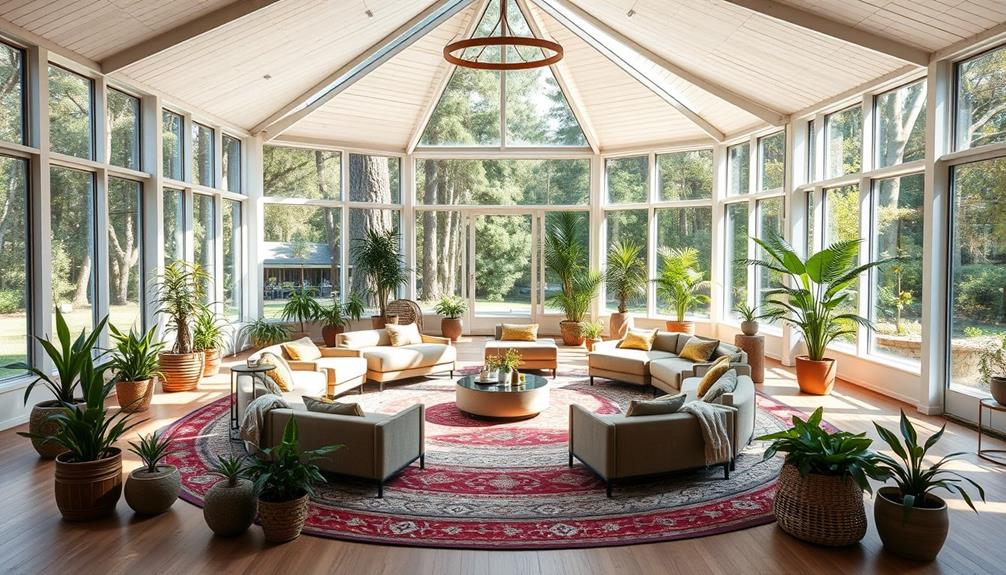
Designing effective spaces for group activities in your retreat center is all about flexibility and comfort. You'll want to create adaptable environments with movable furniture that allow for different setups, from workshops to casual discussions. Incorporating natural elements like ample windows and greenery enhances mood and relaxation. Comfort is key, so include inviting seating and sound-absorbing materials to improve focus. Don't forget essential tech like wireless presentation tools to encourage collaboration. These thoughtful details can greatly boost participant engagement and satisfaction. Keep exploring these strategies to elevate your retreat's atmosphere and foster deeper connections among attendees.
Key Takeaways
- Create flexible spaces with movable furniture to accommodate various activities and foster collaboration among participants.
- Incorporate natural elements and ample natural light to enhance well-being and improve mood in activity areas.
- Design multi-purpose rooms that can be reconfigured for different group activities, ensuring a versatile environment.
- Integrate technology, such as high-speed internet and interactive tools, to support seamless communication and engagement during sessions.
- Prioritize comfortable seating and quiet zones to promote relaxation and deeper connections among attendees.
Importance of Flexible Spaces
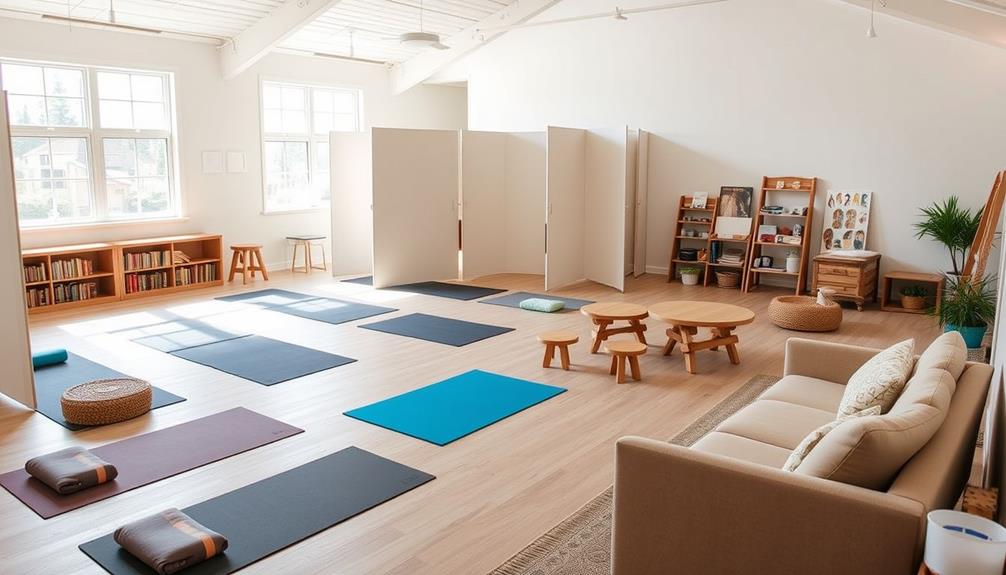
Flexibility is key when it comes to designing spaces for group activities, especially in retreat centers. By incorporating flexible spaces, you can accommodate a variety of activities that cater to different group sizes and dynamic needs. Whether it's workshops, team-building exercises, or relaxation sessions, adaptable environments enhance the overall retreat experience.
Additionally, considering design aspects from building codes and zoning laws can help guarantee that your retreat center meets legal requirements while remaining functional.
Movable furniture plays an essential role in this planning process. It allows you to reconfigure layouts, enabling participants to engage in both collaborative activities and intimate discussions tailored to the retreat's objectives.
Creating areas that shift from formal meeting setups to casual lounge spaces encourages informal interactions, critical for building relationships and fostering connections among participants.
A flexible design approach supports diverse activities, from creative workshops to mindfulness sessions, ultimately enhancing participant engagement and satisfaction. By prioritizing versatility, you can better meet the evolving needs of your attendees.
This not only contributes to improved outcomes but also promotes participant well-being throughout the retreat. Embracing flexible spaces in your retreat center guarantees that everyone can make the most of their experience, leading to lasting memories and deeper connections.
Creating Collaborative Environments
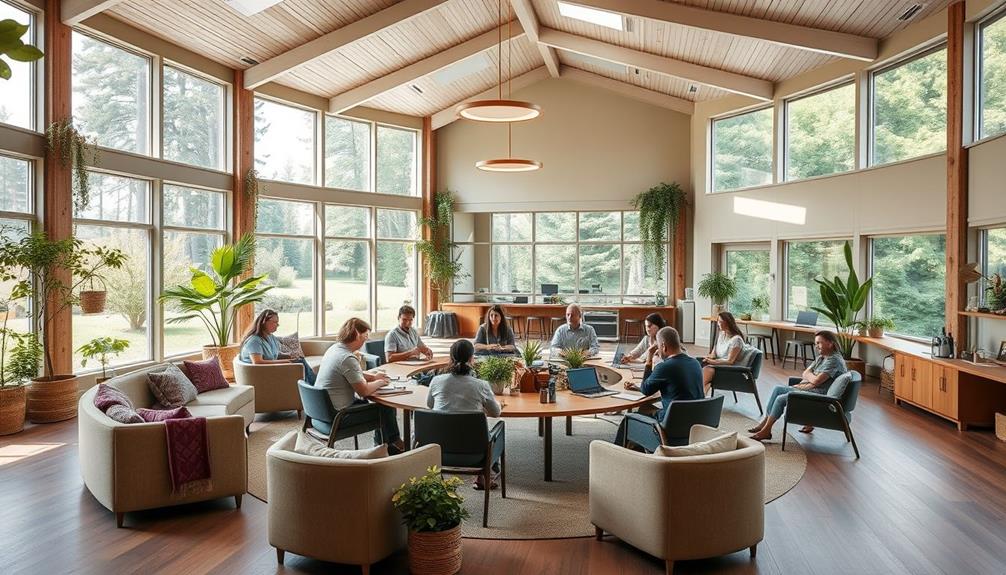
In designing retreat centers, creating collaborative environments is essential for fostering effective teamwork and meaningful interactions.
Start by incorporating flexible seating arrangements that encourage group dynamics, such as circular seating or movable furniture. This allows participants to easily reconfigure their space for discussions and brainstorming sessions.
Additionally, consider integrating elements like a DIY fire pit to enhance outdoor spaces, providing a relaxing atmosphere for informal gatherings and discussions.
Breakout rooms or designated areas within your center are vital for smaller group discussions. These spaces foster deeper connections and focused collaborative efforts, ensuring everyone has a chance to contribute.
Utilizing natural light is another key element. Studies show that exposure to daylight positively impacts mood and productivity, so aim to design spaces with large windows or access to outdoor areas.
Don't forget to integrate technology like whiteboards, projectors, and video conferencing tools. These resources facilitate collaboration during workshops, making it easier for all participants to engage.
Incorporating Natural Elements
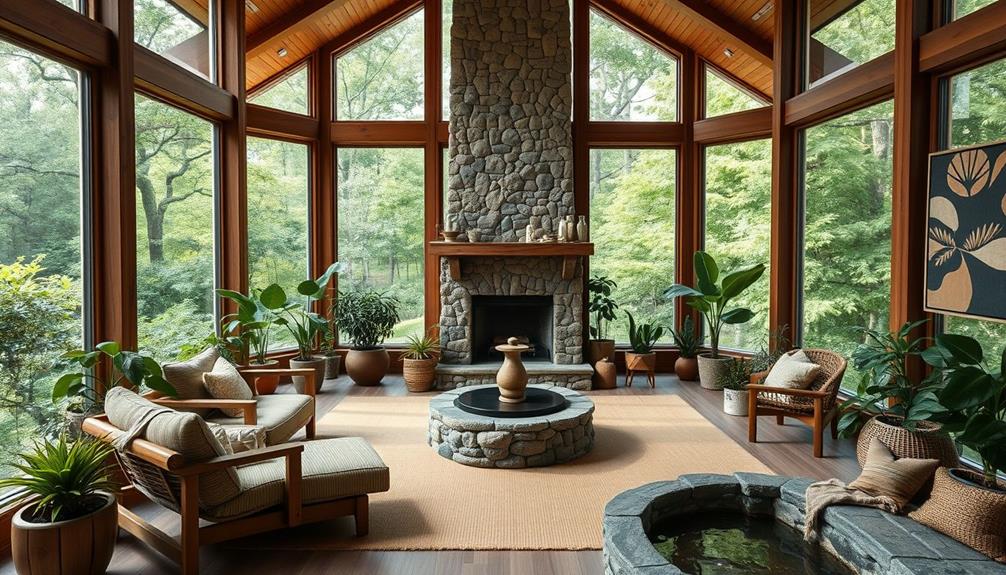
When designing retreat spaces, incorporating natural elements like wood, stone, and greenery greatly enhances participants' sense of calm and well-being. By creating an environment that mimics nature, you foster relaxation and creativity, which are essential for achieving retreat goals.New England offers diverse tent camping locations that showcase the beauty of natural settings, making them ideal for inspiring such environments.
- Utilize ample windows or skylights to enhance natural light, boosting mood and productivity.
- Integrate indoor gardens or green walls, reducing stress and improving cognitive function.
- Include outdoor spaces like patios or gardens, allowing for flexible activities in serene settings.
- Consider adding water features, such as fountains or ponds, to lower stress and enrich the overall experience.
Incorporating natural elements in your retreat location not only aligns with participants' needs but also cultivates an engaging retreat atmosphere.
By thoughtfully designing spaces that invite the outdoors in, you encourage deeper discussions and connections during group activities.
Emphasizing these elements will create a more inviting and restorative environment, making it easier for everyone to engage fully while pursuing their goals.
Designing for Comfort and Engagement
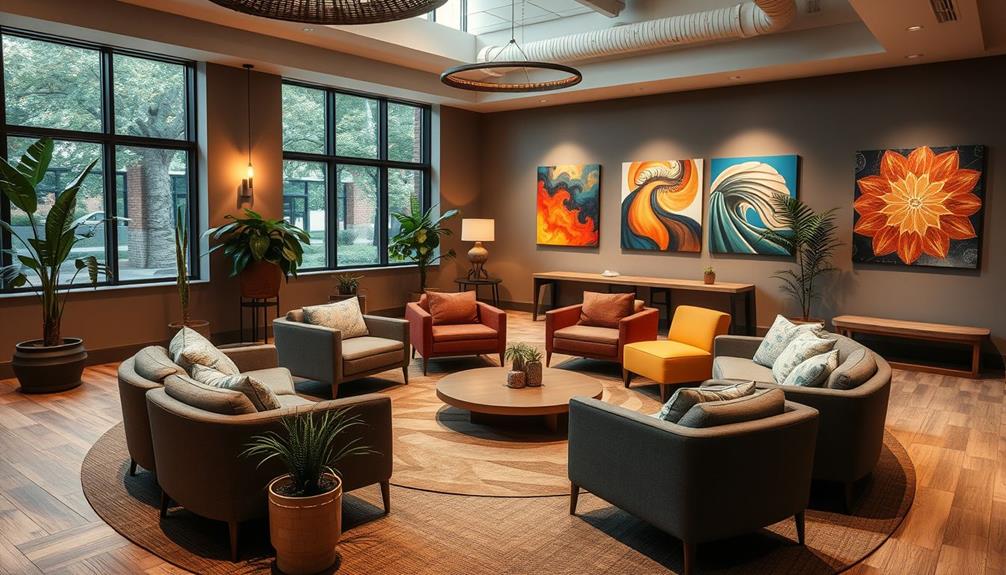
Creating spaces that prioritize comfort and engagement is vital for fostering a productive retreat environment. Start by designing comfortable seating arrangements with varied options like couches, armchairs, and floor cushions. This variety encourages relaxation and promotes engagement during group activities.
Additionally, incorporate natural lighting through large windows and skylights. This not only enhances the mood but also boosts focus, making the space more inviting for participation. Consider integrating features that mirror successful designs from spaces like mechanic shops for fuel injection cleaning, which often prioritize both functionality and comfort for their clients.
Next, pay attention to acoustic considerations. Using sound-absorbing materials helps minimize distractions and guarantees clear communication during discussions. This is key for maintaining an engaging atmosphere.
Consider including breakout areas or smaller rooms within the retreat center. These intimate spaces foster deeper connections among participants, allowing for collaborative work and meaningful conversations.
Lastly, utilize flexible layouts and movable furniture. This adaptability accommodates diverse activities, from workshops to casual gatherings, enhancing the overall functionality and comfort of the space.
Activity-Specific Space Considerations

To maximize the effectiveness of group activities, it's essential to design spaces that can adapt to various needs and purposes.
Consider the following elements to enhance your retreat center:
- Create flexible multi-purpose rooms that can be easily reconfigured for workshops, team-building exercises, or quiet reflection. Incorporating aspects of emotional and psychological support can foster a more inclusive environment for all participants.
- Incorporate outdoor spaces for activities like yoga, nature walks, or team-building games, leveraging fresh air for increased engagement.
- Make sure communal areas feature comfortable seating and accessible technology, fostering creativity during group discussions and collaborative work.
- Establish dedicated quiet zones that promote relaxation and introspection, allowing attendees to recharge and reflect.
Enhancing Atmosphere With Technology
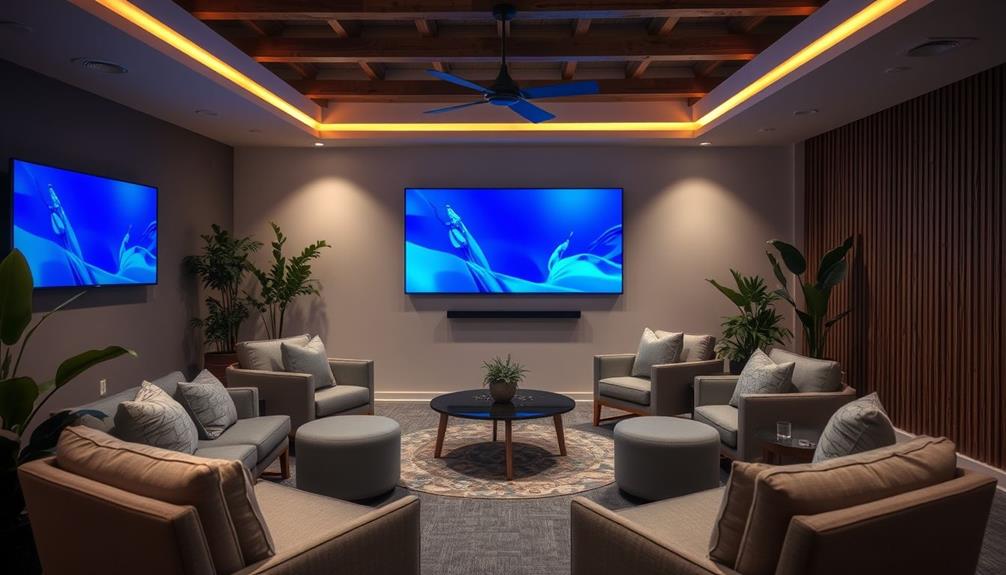
Incorporating technology into your retreat center can greatly enhance the atmosphere for group activities. By implementing high-quality audio systems, you guarantee that presentations, music, and guided sessions resonate clearly, boosting participant engagement and overall experience. Clear sound can make a notable difference in how groups connect and interact with the content being shared, much like how Blue Skies and Lemonade captures the essence of joy and warmth in music.
Integrating smart lighting systems allows you to customize the ambiance in your activity spaces. You can easily adjust the lighting from bright and energizing to soft and calming, tailoring the mood to fit the specific needs of each session. This flexibility can greatly impact the overall atmosphere and participants' comfort.
Utilizing wireless presentation technology fosters seamless content sharing during workshops and discussions, encouraging collaboration and interaction among participants. Furthermore, offering high-speed internet access guarantees remote attendees feel included and engaged, allowing for virtual participation that enriches group activities.
Incorporating interactive tools, like digital whiteboards or polling apps, encourages real-time feedback and participation. This approach enhances the collaborative spirit and creativity within your group activities, making them more dynamic and engaging for everyone involved.
Frequently Asked Questions
How Do You Plan a Creative Retreat?
To plan a creative retreat, define a theme that resonates, schedule diverse activities, choose inspiring venues, include downtime for reflection, and create shared spaces to encourage collaboration and idea exchange among participants for maximum engagement.
What Is the Best Game for a Group Retreat?
If you're looking for a game that sparks creativity, try "The Marshmallow Challenge." It's a fun way to boost collaboration and innovation, letting everyone release their inner architect while bonding over laughter and teamwork.
How Do You Structure a Retreat?
To structure a retreat, you'll start by setting clear objectives. Balance structured activities and downtime, incorporate diverse spaces, stay flexible with the agenda, and tailor experiences to accommodate everyone's comfort and interaction levels.
How Do You Organize a Group Retreat?
To organize a group retreat, define your niche and audience, create a balanced itinerary, select suitable venues, incorporate diverse activities, and guarantee you've got a clear budget and logistical plan for everything involved.
Conclusion
In designing your retreat center, remember that 70% of people say they're more productive in flexible spaces. By creating adaptable environments that foster collaboration and incorporating natural elements, you can enhance comfort and engagement. Don't forget to take into account the specific needs of different activities and utilize technology to elevate the atmosphere. With these thoughtful design choices, you'll cultivate a space that truly inspires connection and creativity among your guests.
- About the Author
- Latest Posts
Introducing Ron, the home decor aficionado at ByRetreat, whose passion for creating beautiful and inviting spaces is at the heart of his work. With his deep knowledge of home decor and his innate sense of style, Ron brings a wealth of expertise and a keen eye for detail to the ByRetreat team.
Ron’s love for home decor goes beyond aesthetics; he understands that our surroundings play a significant role in our overall well-being and productivity. With this in mind, Ron is dedicated to transforming remote workspaces into havens of comfort, functionality, and beauty.
-
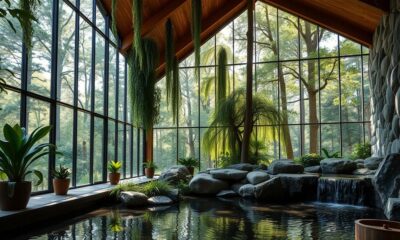
 Retreat3 weeks ago
Retreat3 weeks agoIncorporating Biophilic Design in Your Retreat Center
-
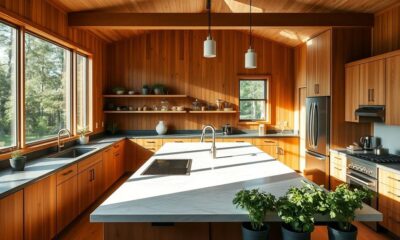
 Retreat3 weeks ago
Retreat3 weeks agoDesigning a Retreat Center Kitchen: From Layout to Equipment
-
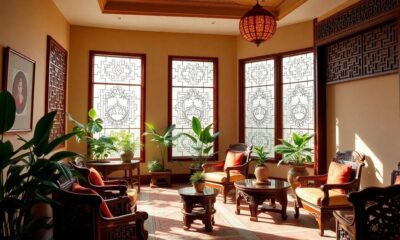
 Southeast Asia Decor4 weeks ago
Southeast Asia Decor4 weeks agoHistorical Feng Shui Color Schemes in Interiors
-
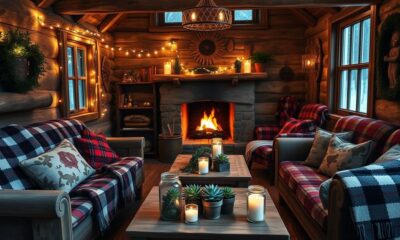
 Retreat3 weeks ago
Retreat3 weeks agoDIY Rustic Decor Ideas for a Cozy Retreat Atmosphere
-

 Southeast Asia Decor4 weeks ago
Southeast Asia Decor4 weeks agoFeng Shui Color Palettes for Your Home
-
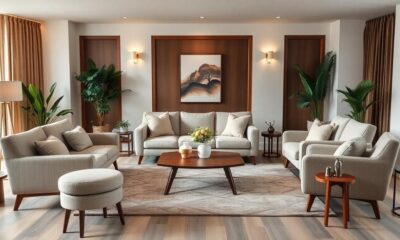
 Southeast Asia Decor2 weeks ago
Southeast Asia Decor2 weeks agoUltimate Guide to Harmonious Furniture Placement
-
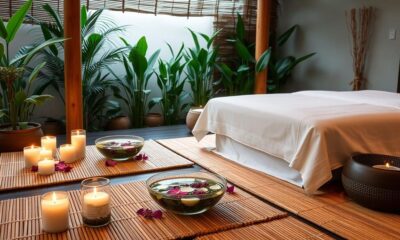
 Retreat4 weeks ago
Retreat4 weeks agoDIY Spa Treatments You Can Offer at Your Retreat Center
-

 Southeast Asia Decor4 weeks ago
Southeast Asia Decor4 weeks agoWhat Are Ideal Feng Shui Color Schemes?










